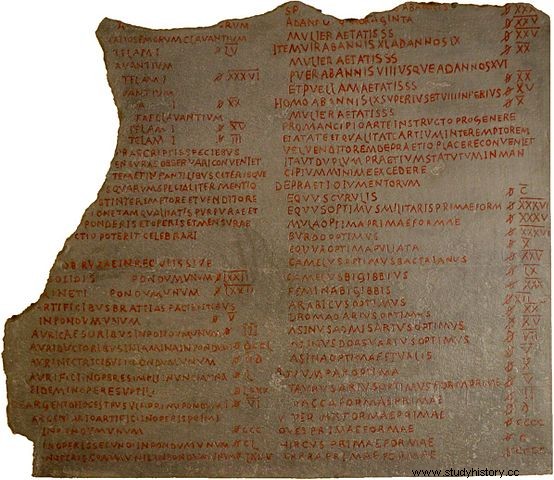We are going to take a walk through ancient Rome and check, thanks to the Edict of Maximum Prices or Edict of Diocletian , what wages some professions received and what prices they had to face. Gaius Aurelius Valerius Diocletian Augustus , for friends Diocletian , was born into a humble family and climbed the military hierarchy until he became commander of the cavalry of the emperor Marco Aurelio Caro . After the death of Caro and his son Numerian , Diocletian was acclaimed emperor by the army and ruled from November 20, 284 to May 1, 305.

Edict Scroll
During the second half of the 3rd century the Roman Empire suffered a serious crisis –imperial crisis – fueled by civil wars, power struggles, barbarian pressure, plague, and a deep economic depression aggravated by the monetary whims (minting their own currency) of greedy emperors. In 301, to put some order, Diocletian decides to promulgate the Edict of Maximum Prices to stabilize the currency and temper the serious economic crisis. Compliance with the edict was mandatory throughout the Empire and, furthermore, setting higher prices was punishable by death. These are some of the prices and salaries, in denarios , who noticed the edict:
- Salaries :
- Agricultural worker – 25 a day
- Carpenter or mason – 50 a day
- Painter (broad brush) – 75 a day
- Painter (frame) – 150 a day
- Wool Weaver – 175 per cloak
- Baker – 50 a day
- Building ships, rivers and sea – 50 and 60 a day respectively .
- Arriero – 25 a day
- Barber/hairdresser – 2 per person
- Sewer cleaner –25 a day
- Type, to improve writing – 25 per 100 lines . Drafting petitions or public documents – 10 per 100 lines .
- Teacher:from 50 per month per student for children up to 250 per month per student for Rhetoric students .
- Average legionnaire – 15,400 a year including the value of the wheat they received per year.
- Praetorian Guard – 19,000 a year including wheat.
- Prices
- Wheat, a mod (8.75 kg.) – 100
- Barley and rye, one mode – 60
- Lentils, one mode – 100
- Salt, a mod – 100
- Beans, one mod – 100
- Rice, one mode – 200
- Wine, such as a Rioja or Ribera del Duero, a sextarius (1/2 liter) – 30
- Table or house wine, a sextarius – between 8 and 16
- Gallic beer, a sextarius – 4
- Egyptian beer, a sextarius – 2
- Honey, like that of the Alcarria, a sextarius – 40
- Olive oil, a sextarius – 40
- Pork or venison, one pound (326 grams) – 12
- Leg of pork, Menapico or Cerritano –20
- Beef, one pound – 8
- One chicken – 60
- One Pheasant – 250
- Sea fish, one pound – between 16 and 24 . For those from the river, one pound – between 8 and 12
- Salted fish, one pound – 6
- Butter, one pound – 16
It is very difficult to make a comparison of these prices with the current ones, but it can serve to give us an idea of what each Roman citizen could acquire with his salary and the differences between the different professions. In addition, we must also take into account that the percentage of the salary that we spend on food has nothing to do with the one used in ancient Rome. As curiosities:the gratification for a victory of a gladiator could be equivalent to the annual salary of a teacher and the charioteer Caius Apuleius Diocles , the Fernando Alonso of the time, he came to earn in his entire career about 35 million sesterces (one denarius – four sesterces) in the second century.
Sources:Forum Ancient Coins, Constantine the Great coins,
